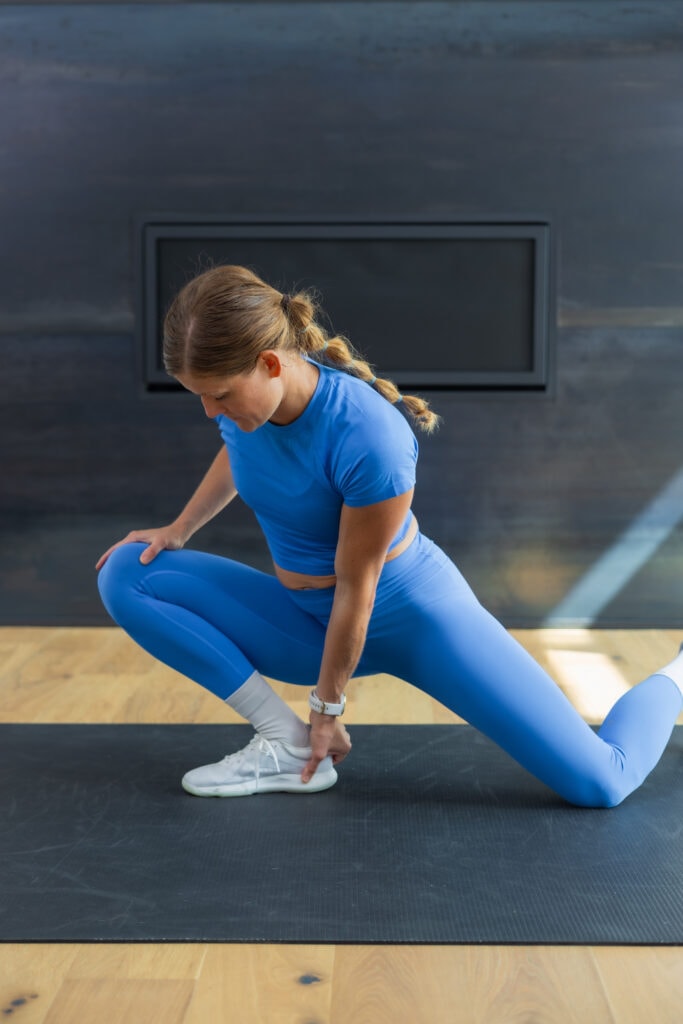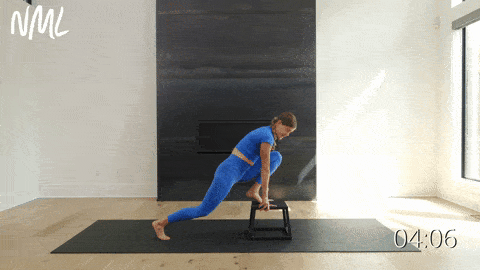
Swiftly Tech Cropped Short-Sleeve
Buy Now →
Improve ankle mobility with this guided routine – the best ankle mobility exercises for strong and healthy ankles. Increase range of motion, and reduce stiffness with this daily mobility routine. These exercises can improve flexibility in the ankles which will lead to better squat form and more effective leg workouts.
Weak, stiff ankles are common – especially for runners or those who participate in high-impact sports and activities.
Overuse or repeated stress on the ankles can weaken them over time. Ankle mobility and ankle strengthening exercises are important in preventing injury and improving your performance in strength training and HIIT workouts.
For example, proper ankle flexion is need to achieve deep squats with good form. Ankle mobility allows the knee to track over the toe through dorsiflexion. If the knee tracks over the toe correctly, you’ll be able to squat deeper, remain more upright, and increase the load you’re lifting.
Strong, flexible ankles also support healthy knees.
Add these ankle mobility exercises to your weekly routine to increase range of motion and boost athletic performance.

Muscle imbalances, less flexibility in the calf muscles, ankle joint issues from a previous injury, or frequently wearing high heels are some of the most common causes of poor ankle mobility. When the ankle is overused or repeatedly subjected to stress from activities like running or high-impact sports, it can also become stiff or tight.
Ankle flexion exercises, like heel lifts, heel drops and squats are an effective way to strengthen the ankles and improve mobility. Most people benefit from adding mobility routines to their workout schedules between two and three times a week. If ankle mobility is a specific goal for you, add ankle mobility exercises to your daily routine. I also suggest working on squats 1-2 times a week.
Having greater ankle mobility means that the ankle joint and its surrounding muscles and tendons are flexible. When your ankle joint is flexible, you’ll have a greater range of motion during your exercises – particularly squats. Better ankle mobility can ultimately improve your leg workouts.

Improve mobility, reduce risk of injury, and get better range of motion during workouts with these daily ankle mobility exercises.
I suggest incorporating mobility workouts like this one to your home workout plan 1-2 times per week to protect and maintain healthy joints and muscles.
Bench or staircase.

Follow along with these guided Ankle Mobility Exercises on YouTube, led by certified personal trainer, Lindsey Bomgren.
Your Workout Looks Like This:
Note: I’ll cue this in the video, but it’s important to actively keep your body from tensing up as you hold each pose. Focus on breathing into each mobility exercise, and think about “releasing” the tension in each muscle group to avoid clenching up.

Purpose: Placing the foot this distance from a wall or bench is a great way to test current ankle mobility. Increasing the ankle dorsiflexion (pushing knees over toes) is a functional training movement. This exercise improves ankle mobility and is a great way to measure progress over time.

Purpose: If you have less range of motion in your ankles, adding an elevation to knees over toes is a great way to progress and measure mobility. Again, increasing the ankle dorsiflexion (pushing knees over toes) is a functional training movement. The heel lower offers a way to modify knees over toes as you gain mobility.

Purpose: Strengthens the calf muscles (gastrocnemius and soleus) and achilles tendon, improves ankle mobility, and increases balance and stability. Adding an incline allows for greater range of motion (as opposed to performing calf raises from the ground).

Purpose: Tib raises strengthen the tibialis anterior muscle, or muscle along the front of the shin (lower leg). This is the primary shock absorber of the knee, and strengthening this muscle can help protect both the knees and ankles. This exercise also increases the ankle dorsiflexion.

Purpose: Ankle mobility improves squat form, so holding the movement we want to improve is beneficial. Deep squats challenge the mobility in your hips, knees, ankles and lumbar spine. Holding a deep squat and side-to-side pry also challenges balance and stability.

Modification: Only lower as far down as possible without the heels lifting off the ground. Your squat hold may not be as deep at the beginning but will improve as your ankle mobility improves.

Swiftly Tech Cropped Short-Sleeve
Buy Now → Buy Now →
Buy Now → 
This post includes affiliate links. I do earn a commission for products purchased using these links (at no additional cost to you). Thank you for supporting Nourish Move Love, making the content you see on this blog possible.